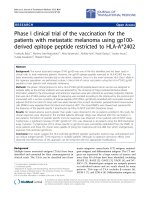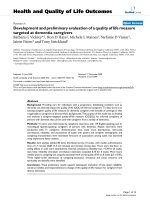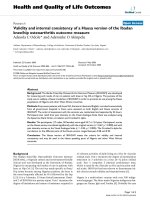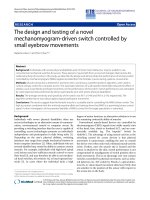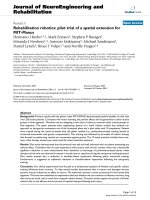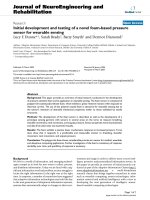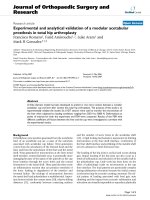báo cáo hóa học: " Rehabilitation robotics: pilot trial of a spatial extension for MIT-Manus" pdf
Bạn đang xem bản rút gọn của tài liệu. Xem và tải ngay bản đầy đủ của tài liệu tại đây (827.05 KB, 15 trang )
BioMed Central
Page 1 of 15
(page number not for citation purposes)
Journal of NeuroEngineering and
Rehabilitation
Open Access
Research
Rehabilitation robotics: pilot trial of a spatial extension for
MIT-Manus
Hermano I Krebs*
1,2
, Mark Ferraro
3
, Stephen P Buerger
1
,
Miranda J Newbery
1,4
, Antonio Makiyama
5
, Michael Sandmann
5
,
Daniel Lynch
3
, Bruce T Volpe
2,3
and Neville Hogan
1,6
Address:
1
Massachusetts Institute of Technology, Mechanical Engineering Department, Cambridge, MA, USA,
2
Weill Medical College of Cornell
University, Department Neurology and Neuroscience, New York, NY, USA,
3
Burke Medical Research Institute, White Plains, NY, USA,
4
Imperial
College, London, UK,
5
Interactive Motion Technologies, Inc., Cambridge, MA, USA and
6
Massachusetts Institute of Technology, Brain and
Cognitive Sciences, Cambridge, MA, USA
Email: Hermano I Krebs* - ; Mark Ferraro - ; Stephen P Buerger - ;
Miranda J Newbery - ; Antonio Makiyama - ;
Michael Sandmann - ; Daniel Lynch - ; Bruce T Volpe - ;
Neville Hogan -
* Corresponding author
Abstract
Background: Previous results with the planar robot MIT-MANUS demonstrated positive benefits in trials with
over 250 stroke patients. Consistent with motor learning, the positive effects did not generalize to other muscle
groups or limb segments. Therefore we are designing a new class of robots to exercise other muscle groups or
limb segments. This paper presents basic engineering aspects of a novel robotic module that extends our
approach to anti-gravity movements out of the horizontal plane and a pilot study with 10 outpatients. Patients
were trained during the initial six-weeks with the planar module (i.e., performance-based training limited to
horizontal movements with gravity compensation). This training was followed by six-weeks of robotic therapy
that focused on performing vertical arm movements against gravity. The 12-week protocol includes three one-
hour robot therapy sessions per week (total 36 robot treatment sessions).
Results: Pilot study demonstrated that the protocol was safe and well tolerated with no patient presenting any
adverse effect. Consistent with our past experience with persons with chronic strokes, there was a statistically
significant reduction in tone measurement from admission to discharge of performance-based planar robot
therapy and we have not observed increases in muscle tone or spasticity during the anti-gravity training protocol.
Pilot results showed also a reduction in shoulder-elbow impairment following planar horizontal training.
Furthermore, it suggested an additional reduction in shoulder-elbow impairment following the anti-gravity
training.
Conclusion: Our clinical experiments have focused on a fundamental question of whether task specific robotic
training influences brain recovery. To date several studies demonstrate that in mature and damaged nervous
systems, nurture indeed has an effect on nature. The improved recovery is most pronounced in the trained limb
segments. We have now embarked on experiments that test whether we can continue to influence recovery, long
after the acute insult, with a novel class of spatial robotic devices. This pilot results support the pursuit of further
clinical trials to test efficacy and the pursuit of optimal therapy following brain injury.
Published: 26 October 2004
Journal of NeuroEngineering and Rehabilitation 2004, 1:5 doi:10.1186/1743-0003-1-5
Received: 30 August 2004
Accepted: 26 October 2004
This article is available from: />© 2004 Krebs et al; licensee BioMed Central Ltd.
This is an open-access article distributed under the terms of the Creative Commons Attribution License ( />),
which permits unrestricted use, distribution, and reproduction in any medium, provided the original work is properly cited.
Journal of NeuroEngineering and Rehabilitation 2004, 1:5 />Page 2 of 15
(page number not for citation purposes)
Background
Rather than using robotics as an assistive technology for a
disabled individual, our research focus is on the develop-
ment and application of robotics as a therapy aid, and in
particular a tool for therapists. We foresee robots and
computers as supporting and enhancing the productivity
of clinicians in their efforts to facilitate a disabled individ-
ual's functional motor recovery. To that end, we deployed
our first robot, MIT-MANUS (see figure 1), at the Burke
Rehabilitation Hospital, White Plains, NY in 1994 [1]. In
the last ten years, MIT-MANUS class robots have been in
daily operation delivering therapy to over 250 stroke
patients. Hospitals presently operating one or more MIT-
MANUS class robots include Burke (NY), Spaulding
(MA), Rhode Island (RI), Osaka Prefectural (Japan) and
Helen Hayes (NY) Rehabilitation Hospitals, and the Bal-
timore (MD) and Cleveland (OH) Veterans Administra-
tion Medical Centers.
Most of the work to date has focused on the fundamental
question of whether task specific training affects motor
outcome and positively influences brain recovery. These
efforts directly confront the overwhelming task of revers-
ing the effects of natural injury where lesion size, type and
location profoundly determine outcome, and applying
controlled conditions in environment and training – nur-
ture – to exploit the ability of the mature nervous system
to learn, adapt and change.
Stroke Inpatient during Therapy at the Burke Rehabilitation Hospital (White Plains, NY)Figure 1
Stroke Inpatient during Therapy at the Burke Rehabilitation Hospital (White Plains, NY). Therapy is being conducted with a
commercial version of MIT-MANUS (Interactive Motion Technologies, Inc., Cambridge, MA).
Journal of NeuroEngineering and Rehabilitation 2004, 1:5 />Page 3 of 15
(page number not for citation purposes)
Through our work with MIT-MANUS, providing task spe-
cific training for patients' with moderate to severe hemi-
paresis, we have gathered convincing evidence
(summarized below) that nurture has a significant impact
in speeding motor recovery of the paretic shoulder and
elbow, and that robot therapy is effective in delivering the
necessary exercise. This recovery is most pronounced in
the trained muscle groups and limb segments. Encour-
aged by these positive results, we have expanded our
project to develop a family of novel, modular robots,
designed to be used independently or together to rehabil-
itate other muscle groups and limb segments. This paper
describes two different implementations of a new module
developed at MIT that expands the capabilities of MIT-
MANUS to include motion in a three-dimensional work-
space. We will present both implementations, the basic
engineering differences between these modules, and pilot
clinical results from their use with stroke patients.
Proof-of-Concept
Volpe [2] reported the composite results of robotic train-
ing with 96 consecutive stroke inpatients admitted to
Burke who met inclusion criteria and consented to partic-
ipate [3-7,2]. Patients were randomly assigned to either an
experimental or control group and although the patient
groups were comparable on all initial clinical evaluation
measures, the robot-trained group demonstrated signifi-
cantly greater motor improvement (higher mean interval
Table 1: Mean interval change in impairment and disability (significance p < 0.05).
Between Group Comparisons: Final Evaluation Minus Initial Evaluation Robot Trained (N = 55) Control (N = 41) P-Value
Impairment Measures (±sem)
Motor Power (MP) 4.1 ± 0.4 2.2 ± 0.3 <0.01
Motor Status shoulder/elbow (MS-se) 8.6 ± 0.8 3.8 ± 0.5 <0.01
Motor Status Wrist/Hand (MS/wh) 4.1 ± 1.1 2.6 ± 0.8 NS
Table 2: Data on the Ten (10) Community Dwelling Stroke Volunteers
Age Handed Lesion foci Lesion side Months stroke Fugl-Meyer adm (/66)
59 Left AVM hem. Left 16.5 11
53 Ambi Intracerebral bleed Left 88.5 18
44 Right Carotid dissection Left 36 11
63 Right Cerebral embolism, subcortical Left 58 9
82 Right Cerebral embolism, subcortical Left 69 9
72 Right Carotid endarectomy Right 24 24
41 Right cortical/subcortical and basal ganglia stroke Right 96 17
72 Right cortical/subcortical stroke Right 47.5 9
57 Right Cerebral embolism, subcortical Right 48 30
77 Right cerebral embolism, mixed Right 16 34
Table 3: Anti-Gravity Vertical Module Pilot Study. Results from nine (9) outpatients that continued for an additional 6 weeks of training
in the vertical module robotic unit. Statistical tests showed that outcomes at discharge from planar robot protocol were distinct from
admission (B vs. A), and there was a trend favoring further improvement when comparing discharge from anti-gravity protocol with
discharge from the planar protocol (C vs. B). Our protocol was safe and did not increase tone.
Timeline N = 9 A – Admission B – Discharge from planar robot protocol C – Discharge from anti-gravity protocol
F-M s/e (/42) 12.7 ± 1.6 14.8 ± 2.0 (p = 0.03, S) 17.0 ± 1.9 (p = 0.19, NS)
MSS s/e (/40) 18.1 ± 1.9 19.9 ± 2.0 (p = 0.01, S) 21.5 ± 1.8 (p = 0.29, NS)
MP 26.5 ± 3.5 33.3 ± 3.6 (p < 0.01, S) 38.8 ± 2.4 (p = 0.07, NS)
Ashworth 8.0 ± 1.4 4.9 ± 0.99 (p < 0.03, S) 4.4 ± 1.01 (p = 0.67, NS)
Journal of NeuroEngineering and Rehabilitation 2004, 1:5 />Page 4 of 15
(page number not for citation purposes)
change ± standard error measurement) than the control
group on the Motor Status and Motor Power scores for
shoulder and elbow (see Table 1). In fact, the robot-
trained group improved twice as much as the control
group in these measures. These gains were specific to
motions of the shoulder and elbow, the focus of the robot
training. There were no significant between-group differ-
ences in the mean change scores for wrist and hand func-
tion. Similar results were gathered in patients who have
had a paralyzed upper extremity after stroke for at least
one year [8-10] (See Table 1).
Description of Robots
Modularity and Integration Potential
MIT's experience with well over 250 stroke patients has
reinforced the importance of one of our core design spec-
ifications: Modularity. From the outset we believed that
modularity is essential to success in robotic therapy, par-
ticularly in extending the approach to patients suffering
from distinct afflictions. Consider, for example, patients
undergoing surgery at the wrist (e.g., Colles Fracture) who
might not require a device that manipulates the payload
of all the degrees-of-freedom (DOF) of the arm. Therapy
for these patients requires only the wrist robot [11-13].
Conversely there will be patients for whom different mod-
ules must be coupled to deliver therapy and carry the pay-
load of the human arm. Presently MIT has deployed four
modules into the clinic (Burke Rehabilitation): a planar 2-
dof active module; vertical 1-dof active module; wrist 3-
dof active module; and 1-dof passive grasp module.
Features common to all modules
All of our robot modules are specifically designed and
built for clinical rehabilitation applications. Unlike most
industrial robots, they are configured for safe, stable, and
compliant operation in close physical contact with
humans. This is achieved using backdrivable hardware
and impedance control, a key feature of the robot control
system. Each active module can move, guide or perturb
movements of a patient's limb and can record motions
and mechanical quantities such as the position, velocity,
and forces applied.
The most profound engineering challenge specific to this
family of robots is achieving the dual goals of high force
production capability and backdrivability. Each module
must be capable of generating sufficient force to move a
patient's limb, but it must also itself be easily movable by
an elderly or frail patient. Backdrivability is essential in
keeping the patient engaged in the task and in allowing
him to observe his successful and unsuccessful attempts at
motion. Backdrivable hardware also improves the per-
formance of systems controlled by impedance controllers.
Achieving backdrivability and high force production,
together in a single machine, is often difficult and
becomes more so when the robot geometry is more
complex.
The robot control system is an impedance controller that
modulates the way the robot reacts to mechanical pertur-
bation from a patient or clinician and ensures a gentle
compliant behavior. Impedance control refers to using a
control system (actuators, sensors and computer) to
impose a desired behavior at a specified port of interac-
tion with a robot, in this case the attachment of the robot
to the patient's hand. Conceived in the early 1980's by
one of the co-authors [14], it has been applied successfully
in numerous robot applications that involve human-
motor interaction. Impedance control has been exten-
sively adopted by other robotics researchers concerned
with human-machine interaction. In rehabilitation robot-
ics impedance control has been successfully implemented
in MIT-MANUS since its clinical debut in 1994. For robots
interacting with the human, the most important feature of
the controller is that its stability is extremely robust to the
uncertainties due to physical contact [14,15]. The stability
of most robot controllers is vulnerable when contacting
objects with unknown dynamics. In contrast, dynamic
interaction with highly variable and poorly characterized
objects (to wit, neurologically impaired patients) will not
de-stabilize the impedance controller above; even inad-
vertent contact with points other than the robot end-effec-
tor will not de-stabilize the controller. This is essential for
safe operation in a clinical context.
Table 4: Anti-Gravity Vertical Module Pilot Study. Results from one naive (1) outpatient that trained for 6 weeks in the vertical module
robotic unit (no prior robot exposure).
Timeline N = 1 B – Admission to anti-gravity protocol C – Discharge from anti-gravity protocol
F-M s/e (/42) 24.0 27.0
MSS s/e (/40) 21.8 31.0
MP 35.0 43.0
Ashworth 4 1
Journal of NeuroEngineering and Rehabilitation 2004, 1:5 />Page 5 of 15
(page number not for citation purposes)
Planar 2-dof robot MIT-MANUS
The MIT-MANUS project was initiated in 1989 with sup-
port from the National Science Foundation. MIT-MANUS
has been in daily operation since 1994 delivering therapy
to stroke patients at the Burke Rehabilitation Hospital.
This robot has been extensively described in the literature
[4] (See Figure 1). MIT-MANUS is a planar module which
provides two translational degrees-of-freedom for elbow
and forearm motion. The 2-dof module is portable (390
N) and consists of a direct-drive five bar-linkage SCARA
(Selective Compliance Assembly Robot Arm). This config-
uration was selected because of its unique characteristics
of low impedance on the horizontal plane and almost
infinite impedance on the vertical axis. These allow a
direct-drive backdrivable robot to easily carry the weight
of the patient's arm. The mechanism is driven by brush-
less motors rated to 9.65 Nm of continuous stall torque
with 16-bit virtual absolute encoders for position and
velocity measurements (higher torques can be produced
for limited periods of time). Redundant velocity sensing
may be provided by DC-tachometers with a sensitivity of
1.8 V/rad/sec. A six degrees-of-freedom force sensor is
mounted on the robot end-effector. The robot control
architecture is implemented in a standard personal com-
puter with 16-bit A/D and D/A I/O cards, as well as a DIO
card with 32 digital lines. Besides its primary control func-
tion, this computer displays the task to both the operator
and the subject or patient via dedicated monitors. Cus-
tom-made hand holders connect a patient's upper limb to
the robot end-effector.
The selected design created a highly backdrivable robot
capable of delivering therapy in a workspace of 15" by 18"
with an end-point anisotropy of 2:1 ratio (2/3 < I < 4/3 Kg;
56.7 < static friction < 113.4 grams) and achievable
impedances between 0 and 8 N/mm. Note that the static
friction is significantly below the just noticeable differ-
ence (JNF) for force, which is 7% of the reference force.
The robot maximum achievable impedance is above the
human perception of 4.2 N/mm for a "virtual wall." The
robot is capable of delivering forces up to 45 N although
the robot target design aimed at a force of 28 N, which
corresponds to the arm strength during elbow extension
for a weak woman in seated position [16].
Vertical 1-dof Novel Robot
Following the successful clinical trials of MIT-MANUS, a
1-dof module to provide vertical motion and force was
conceived and built. The primary goal of this module is to
bring the benefits of planar therapy on MIT-MANUS to
spatial arm movements, including movement against
gravity. The module can be used independently or
mounted to MIT-MANUS for movement in a limited spa-
tial workspace. The module can permit free motion of the
patient's arm, or can provide partial or full assistance or
resistance as the patient moves against gravity. Because the
vertical module moves with the endpoint of the planar
module when the two are integrated, overall module mass
is an important design concern in addition to on-axis
mass and friction. Two embodiments are described
below.
Screw-driven module
One prototype of the 1-dof module was completed at MIT
late 2000 and is shown alongside a test stand in Figure 2.
A second clone was completed at MIT and deployed in the
clinic (Burke Rehabilitation Hospital), where it is pres-
ently collecting pilot data with stroke patients. The mod-
ule incorporates a custom-made "rollnut" and a custom-
made screw with a linear guide system. Significant effort
was engaged in the design of the screw transmission,
which provides an efficient conversion of rotary to linear
motion designed to eliminate nearly all-sliding friction in
favor of rolling contact. Its low friction provides an intrin-
sically back-drivable design. The bracket mounted to the
rollnut allows the attachment of different interfaces.
Incorporated into the design are therapists' suggestions
that functional reaching movements often occur in a
range of motion close to shoulder scaption. Thus, the
robotic therapy games that use the spatial robot focus on
movements within the 45° to 65° range of shoulder
abduction and from 30° to 90° of shoulder elevation or
flexion. A Gripmate
is used to
hold the patient's hand in place.
This prototype has been fully characterized at MIT [17,18]
(Figures 4 and 5). In comparison to MIT-MANUS, the ver-
tical module has a greater effective endpoint mass and
friction, though the resulting system is still back-drivable.
In order to partially compensate for this increased imped-
ance, force-feedback is incorporated into the impedance
controller, resulting in a substantial reduction in friction,
down to approximately 3 N, and mass, to approximately
1 kg. This improvement is illustrated in Figure 3. The
module is capable of providing well over the force specifi-
cation of 65 N in the upward direction (20 N estimate of
patient's arm weigh) and 45 N in the downward direction,
and can achieve stiffness in excess of 10 N/mm, far greater
than the values generally used for therapy.
Linear direct-drive module
The screw-driven prototype has proven very successful
both in standalone operation and mounted at the end of
the planar module enabling spatial movement therapy in
the clinic with compliant and stable behavior. However
recent changes in linear motor technology have created
the potential to achieve similar outcomes with effective
vertical endpoint inertia comparable to the planar MIT-
MANUS and much lower friction, without the need for
Journal of NeuroEngineering and Rehabilitation 2004, 1:5 />Page 6 of 15
(page number not for citation purposes)
Constant-Velocity Friction Experiments (0.5 to 50 mm/sec)Figure 2
Constant-Velocity Friction Experiments (0.5 to 50 mm/sec). Photo shows alpha-prototype. The mean friction force was 20.075
± 1.056 N.
Journal of NeuroEngineering and Rehabilitation 2004, 1:5 />Page 7 of 15
(page number not for citation purposes)
force feedback control. The main change is complete
enclosure of the magnets within the motor forcer. While
this does not increase the magnetic field strength, it dra-
matically increases the line integral and concatenates
magnetic lines.
The practical advantages of converting the spatial system
to direct-drive linear motors would be a significant reduc-
tion of friction and elimination of backlash. This
simplification would also carry through to the control sys-
tem and controller, as well as affording a reduction in the
system's overall dimensions and weight. To determine if
the expected friction levels are realistic, we tested Copley
Control ThrustTube TB2504. Figures 6 ,7, 8 shows our
experimental results characterizing the static friction for
the TB series and the force vs current relationship. Figures
9 and 10 shows the commercial implementation of the
novel module (Interactive Motion Technologies, Inc.,
Cambridge, MA). The novel module allows 19.4" of linear
range of motion and it is capable of moving the desired
target maximum endpoint force of 65 N upward and 45 N
downward. This new module achieves significant reduc-
tions in friction and inertia to 25% and 76% of the lead-
screw prototype.
The graph shows force versus position with spring behavior commanded (heavy dot)Figure 3
The graph shows force versus position with spring behavior commanded (heavy dot). PD controller alone (solid), PD control-
ler with force feedback, K
f
= 5 (dashed). Qualitatively, the roughly 3 N of friction force is almost imperceptible.
Journal of NeuroEngineering and Rehabilitation 2004, 1:5 />Page 8 of 15
(page number not for citation purposes)
Pilot Clinical Trials with the Anti-gravity Module
To test the novel vertical module we conducted a pilot
study to analyze whether additional anti-gravity training
further improves motor outcomes for "graduates" of the
planar robot-assisted protocol.
In-/Exclusion Criteria
Outpatients were included in the study if they met the fol-
lowing criteria: a) first single focal unilateral lesion with
diagnosis verified by brain imaging (MRI or CT scans) that
occurred at least 6 months prior; b) cognitive function
sufficient to understand the experiments and follow
instructions (Mini-Mental Status Score of 22 and higher or
interview for aphasic subjects); c) Motor Power score ≥1/
5 or ≤3/5 (neither hemiplegic nor fully recovered motor
function in the 14 muscles of the shoulder and elbow); d)
informed written consent to participate in the study.
Patients were excluded from the study if they have a fixed
contracture deformity in the affected limb that limited
pain-free range of motion. We have found severe tendon
contractures around the rotator cuff particularly, in
patients with complete hemiplegia for longer than 6
months after stroke. It is reasonable to expect that robotic
training for the upper limb would not have an impact on
a fixed contracture deformity. Trials commenced only
after baseline assessment across three consecutive evalua-
tions, 2 weeks apart, shows a stable condition in three
motor impairment scales (F-M, MSS, MP). Our rationale
for administering multiple baseline evaluations is based
on an interesting "Hawthorne effect" that we observed in
Graduates from Planar Robot Protocol Receiving Additional Vertical Anti-Gravity Training at the Burke Rehabilitation Hospital (White Plains, NY)Figure 4
Graduates from Planar Robot Protocol Receiving Additional Vertical Anti-Gravity Training at the Burke Rehabilitation Hospital
(White Plains, NY). The robot is sufficiently backdrivable to be lifted with the tip of the little finger.
Journal of NeuroEngineering and Rehabilitation 2004, 1:5 />Page 9 of 15
(page number not for citation purposes)
previous subjects [19,20]. Between first and second pre-
treatment evaluations, some subjects have shown a
remarkable improvement in clinical impairment scores.
We speculate that the anticipated participation in a
research study may contribute to a significant change in
life routines.
Demographics
Ten (10) community dwelling volunteers who have suf-
fered a single stroke at least 6 months prior to enrollment
were enrolled in the pilot protocol. The mean group age
was 62 ± 4.3 years old (mean ± sem) with the onset of the
stroke occurring 50 ± 8.9 months (mean ± sem) prior to
enrollment. Table 2 summarizes admission status of vol-
unteers (See Table 2).
Description of Protocol
Patients were trained during the initial six-weeks with the
planar module (i.e., training limited to horizontal move-
ments with gravity compensation as in past studies). This
training was followed by six-weeks of robotic therapy that
focused on performing vertical arm movements against
gravity. The 12-week protocol includes three one-hour
robot therapy sessions per week (total 36 robot treatment
sessions) (Figure 9).
For shoulder-and-elbow planar therapy, the center of the
workspace was located in front of the subject at the body
midline with the shoulder elevation at 30° with the elbow
slighted flexed. The point-to-point movements started at
the workspace center and extended in eight different
Graduates from Planar Robot Protocol Receiving Additional Vertical Anti-Gravity Training at the Burke Rehabilitation Hospital (White Plains, NY)Figure 5
Graduates from Planar Robot Protocol Receiving Additional Vertical Anti-Gravity Training at the Burke Rehabilitation Hospital
(White Plains, NY). The robot is sufficiently backdrivable to be lifted with the tip of the little finger.
Journal of NeuroEngineering and Rehabilitation 2004, 1:5 />Page 10 of 15
(page number not for citation purposes)
directions of the compass (Figure 11). A one-hour session
included two batches of 20 repetitions of point-to-point
movements. The protocol incorporated a novel
performance-based adaptive algorithm [21], which
encouraged subjects to initiate movement with their
hemiparetic arm.
Just as in the planar study [10], the anti-gravity robotic
protocols consisted of visually evoked and visually guided
point-to-point movements to different targets (along two
vertical lines) with some robotic therapy games providing
assistance and others visual feedback only. The protocol
incorporated therapists' suggestions: a) robot therapy
should focus on encouraging subjects to initiate move-
ment against gravity with their hemiparetic arm beginning
in a position of slight shoulder flexion (elevation) and
scaption; b) functional reaching movements often occur
in a range of motion close to shoulder scaption; c) no sup-
port should be provided at the elbow; and d) the visual
display should be kept simple, since more complex dis-
plays proved to be difficult for our historical pool of
stroke survivors to follow. Thus the robotic therapy proto-
cols with the spatial robot focused on movements within
the 45° to 65° range of shoulder abduction and between
Characterization of TB2504Figure 6
Characterization of TB2504. Plot shows the force versus current curve.
Journal of NeuroEngineering and Rehabilitation 2004, 1:5 />Page 11 of 15
(page number not for citation purposes)
30° to 90° of shoulder elevation or flexion. This sector is
considered "safe" for the shoulder joint because it
prevents gleno-humeral impingement that may occur
when attempting to elevate the paretic limb to higher lev-
els of shoulder elevation; The one-hour session included
three batches of 20 repetitions of point-to-point
movements. The first batch only provided visual feedback
to a repetitive sequence of targets, while the second and
third batches assisted the subject if needed to reach the
target.
Clinical Assessment Scales
In this pilot, standard clinical evaluations included the
upper extremity sub-test of the Fugl-Meyer Assessment
(FM, maximum score = 66) from which we derived a Fugl-
Meyer score for shoulder/elbow coordination (FM-SE, 42
out of 66); a more comprehensive evaluation of motor
power or strength in 14 different muscle groups of the
shoulder and elbow, using the MRC Motor Power score
(MP, out of 70); and the Motor Status Score which is
divided into two subscales, one for shoulder and elbow
movements (MS-SE, maximum score = 40), and a second
for wrist and hand abilities (MS-WH, maximum score =
42) [22,3,23,24,6,7]. The Modified Ashworth Scale
(Bohannon, 1987) provides a measure of tone. The Fugl-
Meyer test is a widely accepted measure of impairment in
sensorimotor and functional grasp abilities [24]. To
complement the Fugl-Meyer, we developed the Motor Sta-
Characterization of TB2504Figure 7
Characterization of TB2504. Plot shows the static friction and cogging.
Journal of NeuroEngineering and Rehabilitation 2004, 1:5 />Page 12 of 15
(page number not for citation purposes)
Characterization of TB2504Figure 8
Characterization of TB2504.
Vertical 1-dof Module Using Electrical Linear TechnologyFigure 9
Vertical 1-dof Module Using Electrical Linear Technology. This commercial version of MIT's module can be operated in stan-
dalone fashion or integrated to the planar MIT-MANUS to allow spatial movements. Note that in the standalone fashion it can
be operated at any angle to the horizontal and vertical planes with adjustable handle positions.
Journal of NeuroEngineering and Rehabilitation 2004, 1:5 />Page 13 of 15
(page number not for citation purposes)
tus to further quantify discrete and functional movements
in the upper limb. The MS-SE and MS-WH scales expand
the F-M and have met the standards for inter rater reliabil-
ity, significant intra-class correlation coefficients and
internal item consistency [23,25].
Results
We have completed the study with ten (10) outpatients.
Nine (9) outpatients who completed the planar training
protocol at the Burke Rehabilitation Hospital were
enrolled for an additional six-weeks with training three
sessions per week on the vertical module. One (1) naïve
outpatient completed only the six-week training on the
vertical module (no previous exposure to the planar train-
ing). Table 3 and 4 shows the results for the shoulder-and-
elbow subcomponent of the upper extremity Fugl-Meyer
scale, the Motor Status Score, Motor Power, and Modified
Ashworth scale.
Results of this pilot suggested that the vertical protocol
was safe and well tolerated by the patients with no patient
presenting any adverse effect (e.g., shoulder pain). Fur-
thermore, pilot results suggested an additional reduction
in shoulder-elbow impairment following the anti-gravity
vertical training. In fact, for these 9 patients the reduction
in impairment during the vertical training phase was com-
parable to the reduction during the planar phase (5.2%
for the vertical training vs 5.0% for the planar training of
the shoulder-elbow subcomponent of the Fugl-Meyer
scale – albeit without achieving statistical significance). As
Vertical 1-dof Module Using Electrical Linear TechnologyFigure 10
Vertical 1-dof Module Using Electrical Linear Technology. This commercial version of MIT's module can be operated in stan-
dalone fashion or integrated to the planar MIT-MANUS to allow spatial movements. Note that in the standalone fashion it can
be operated at any angle to the horizontal and vertical planes with adjustable handle positions.
Journal of NeuroEngineering and Rehabilitation 2004, 1:5 />Page 14 of 15
(page number not for citation purposes)
mentioned earlier, we reliably incorporated therapists'
feedback during the design phase of the protocol and have
not observed increases in muscle tone or spasticity, as
indicated by the Modified Ashworth scale, during the anti-
gravity training protocol (actually the trend in 8 out of 9
patients is towards a decrease in tone). Note also that con-
sistent with our past experience with the persons with
chronic strokes, there was a statistically significant reduc-
tion in tone measurement from admission to discharge of
performance-based planar robot therapy.
While the benefits from the additional anti-gravity ther-
apy did not achieve statistical significance, this is likely
due to the small sample size (9 outpatients). We antici-
pate that a modest increase of sample size will demon-
strate statistical improvement for the shoulder and elbow
of the anti-gravity training across the three clinical scales
and we plan to commence trials shortly (See Table 3 and
Table 4).
Conclusions
Our clinical experiments have focused on a fundamental
question of whether task specific robotic training influ-
ences brain recovery. To date several studies demonstrate
that in mature and damaged nervous systems, nurture
indeed has an effect on nature. The improved recovery is
most pronounced in the trained limb segments (i.e.
shoulder and elbow). We have now embarked on experi-
ments that will test whether we can continue to influence
recovery, long after the acute insult, with a novel class of
robotic devices.
It is broadly accepted that outcome measures do not sig-
nificantly change in persons with chronic motor impair-
ments more than six months from stroke onset. However,
recent task specific training programs have resulted in
improved motor performance in persons with chronic
stroke. For example, our trials with persons with chronic
stroke-related impairments showed that planar robotic
training contributed to statistically significant improve-
ments in motor abilities [8-10]. If so, further robot train-
ing of stroke survivors who were enrolled in the planar
robot trials might result in additional performance
improvements when a distinct training protocol is
provided.
Our pilot results and novel robotic modules provide a
proof of concept that supports our engineering efforts, as
well as further clinical trials to test efficacy. We found that
the protocol was safe and well tolerated by the patients
with no patient presenting any adverse effect (e.g., shoul-
der pain). Furthermore, the pilot results suggested an
additional reduction in shoulder-elbow impairment fol-
lowing the anti-gravity vertical training without detrimen-
tal changes in muscle tone or spasticity. Therefore we plan
to investigate in detail the effect of training each
movement component in isolation versus integrated spa-
tial movement, and study its impact on disability. We
expect that this will bring us closer to our ultimate goal,
efficient delivery of optimal therapy, personalized to serve
the individual's needs.
Acknowledgements
This work was supported by a grant from the Burke Medical Research Insti-
tute. Dr. Makiyama and Sandmann were supported by National Institute of
Child Health and Development of N.I.H., Grant 1 R43 HD42900-01.
References
1. Hogan N, Krebs HI, Sharon A, Charnnarong J: Interactive robot
therapist. MIT: #5,466,213, USA. November 14, 1995
2. Volpe BT, Krebs HI, Hogan N: Is robot-aided sensorimotor
training in stroke rehabilitation a realistic option? Curr Opin
Neurol 2001, 14:745-752.
3. Aisen ML, Krebs HI, Hogan N, McDowell F, Volpe BT: The effect of
robot-assisted therapy and rehabilitative training on motor
recovery following stroke. Arch Neurol 1997, 54:443-446.
4. Krebs HI, Hogan N, Aisen ML, Volpe BT: Robot-aided
neurorehabilitation. IEEE Trans Rehabil Eng 1998, 6:75-87.
Movement Component TrainingFigure 11
Movement Component Training. The circular display in front
of the subject represents the workspace of the planar 6-
weeks trial. The component training added 6 additional
weeks training movements over two vertical lines.
Publish with BioMed Central and every
scientist can read your work free of charge
"BioMed Central will be the most significant development for
disseminating the results of biomedical research in our lifetime."
Sir Paul Nurse, Cancer Research UK
Your research papers will be:
available free of charge to the entire biomedical community
peer reviewed and published immediately upon acceptance
cited in PubMed and archived on PubMed Central
yours — you keep the copyright
Submit your manuscript here:
/>BioMedcentral
Journal of NeuroEngineering and Rehabilitation 2004, 1:5 />Page 15 of 15
(page number not for citation purposes)
5. Krebs HI, Volpe BT, Aisen ML, Hogan N: Increasing Productivity
and Quality of Care: Robot-Aided Neurorehabilitation. J
Rehabil Res Dev 2000, 37(6):639-652.
6. Volpe BT, Krebs HI, Hogan N, Edelsteinn L, Diels CM, Aisen ML:
Robot training enhanced motor outcome in patients with
stroke maintained over 3 years. Neurology 1999, 53:1874-1876.
7. Volpe BT, Krebs HI, Hogan N, Edelstein OL, Diels C, Aisen M: A
novel approach to stroke rehabilitation: robot-aided sensori-
motor stimulation. Neurology 2000, 54:1938-1944.
8. Fasoli SD, Krebs HI, Stein J, Frontera WR, Hogan N: Effects of
robotic therapy on motor impairment and recovery in
chronic stroke. Arch Phys Med Rehabil 2003, 84:477-482.
9. Fasoli SD, Krebs HI, Stein J, Frontera WR, Hughes R, Hogan N:
Robotic therapy for chronic motor impairments after
stroke: follow-up results. Arch Phys Med Rehabil 2004,
85(7):1106-1111.
10. Ferraro M, Palazzolo JJ, Krol J, Krebs HI, Hogan N, Volpe BT: Robot
aided sensorimotor arm training improves outcome in
patients with chronic stroke. Neurology 2003, 61:1604-1607.
11. Williams DJ, Krebs HI, Hogan N: A robot for wrist rehabilitation.
IEEE – 23rd EMBS; Istanbul, Turkey 2001.
12. Celestino J, Krebs HI, Hogan N: A robot for wrist rehabilitation:
characterization and initial results. ICORR 2003, Korea 2003.
13. Krebs HI, Celestino J, Williams D, Ferraro M, Volpe BT, Hogan N: A
wrist extension to MIT-MANUS. In In Advances in Human-Friendly
Robotic Technologies for Movement Assistance/Movement Restoration for
People with Disabilities Edited by: Bien Z, Stefanov D. Springer-Verlag
Series: Lecture Notes in Control and Information Sciences; 2004.
14. Hogan N: Impedance control: an approach to manipulation. J
Dyn Syst Measure Control 1985, 107:1-24.
15. Colgate JE, Hogan N: Robust control of dynamically interacting
systems. International Journal of Control 1988, 48(1):65-88.
16. Diffrient N, Tilley AR, Harman D: Humanscale 7/8/9 Cambridge, MA:
MIT Press; 1981.
17. Krebs HI, Buerger SP, Jugenheimer KA, Williams D, Hogan N: 3-D
extension for MIT-MANUS: a robot-aided neuro-rehabilita-
tion workstation. ASME 2000 IDETC/CIE, DETC2000/MECH-14151,
Baltimore 2000.
18. Buerger SP, Krebs HI, Hogan N: Characterization and Control of
a Screw-Driven Robot for Neurorehabilitation. IEEE – CCA/ISIC
2001; Mexico City 2001.
19. Mayo , Elton : The Human Problems of an Industrial Civilization New
York: Macmillan; 1933.
20. Roethlisberger F, Dickson W: Management and the Worker: An account
of a research program conducted by the Western Electric Company,
Chicago Cambridge, MA: Harvard University Press; 1939.
21. Krebs HI, Palazzolo JJ, Dipietro L, Ferraro M, Krol J, Rannekleiv K,
Volpe BT, Hogan N: Rehabilitation Robotics: Performance-
based Progressive Robot-Assisted Therapy. Autonomous Robots
2003, 15:7-20.
22. Aisen ML, Sevilla D, Gibson G, Kutt H, Blau A, Edelstein L, Hatch J,
Blass J: 3,4-diaminopyridine as a treatment for amyotrophic
lateral sclerosis. J Neurol Sci 1995, 129:21-24.
23. Ferraro M, Demaio JH, Krol J, Trudell C, Edelstein L, Christos P, Eng-
land J, Fasoli S, Aisen ML, Krebs HI, Hogan N, Volpe BT: Assessing
the motor status score: A scale for the evaluation of upper
limb motor outcomes in patients after stroke. Neurorehabil
Neural Repair 2002, 16(3):283-289.
24. Fugl-Meyer AR, Jaasko L, Leyman I, Olsson S, Steglind S: The post-
stroke hemiplegic patient. 1. a method for evaluation of
physical performance. Scand J Rehabil Med 1975, 7:13-31.
25. Krebs HI, Volpe BT, Ferraro M, Fasoli S, Palazzolo J, Rohrer B, Edel-
stein L, Hogan N: Robot aided neurorehabilitation: from evi-
dence based to science based rehabilitation. Top Stroke Rehabil
2002, 8(4):54-70.

